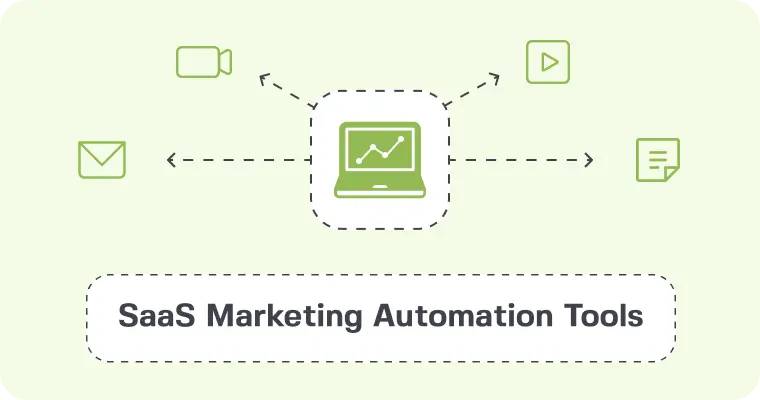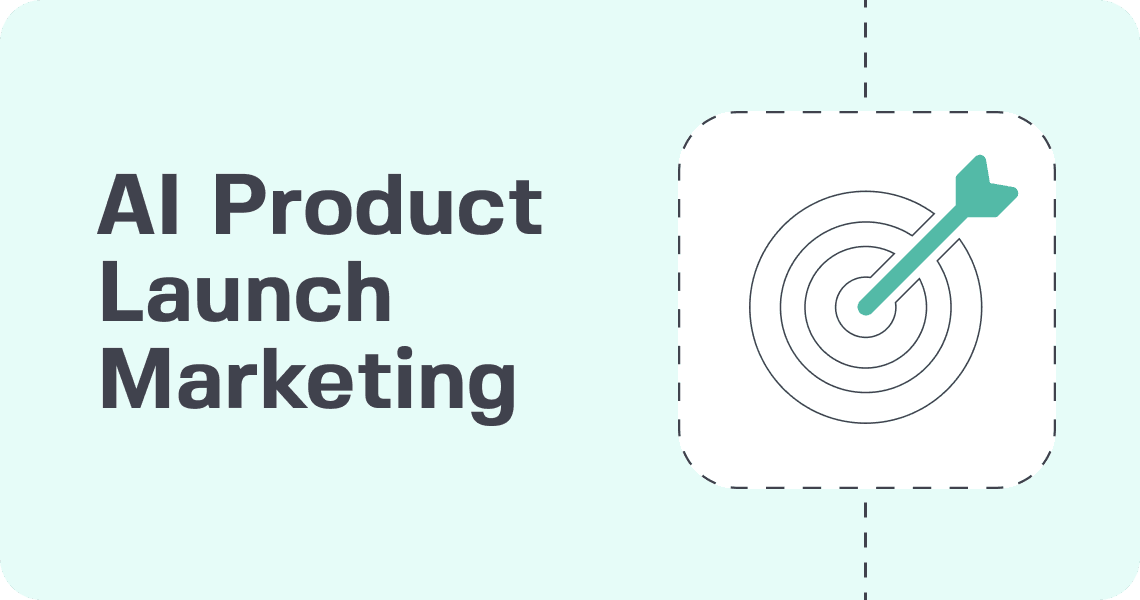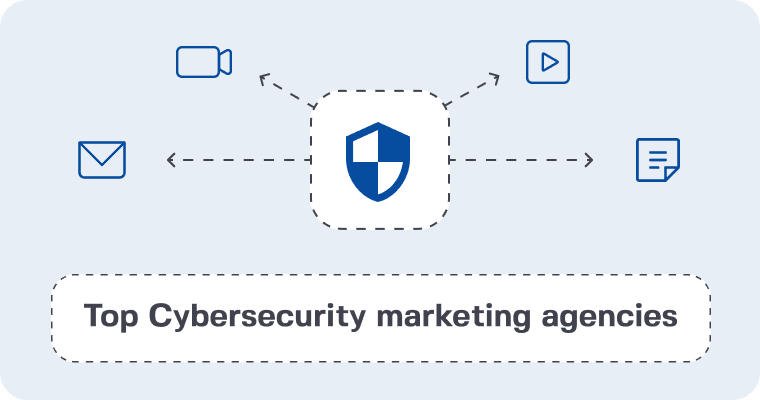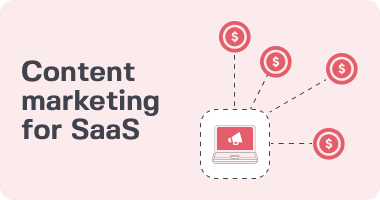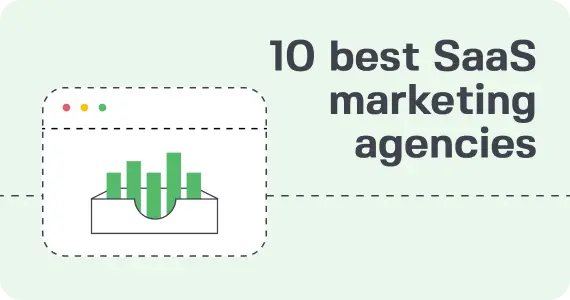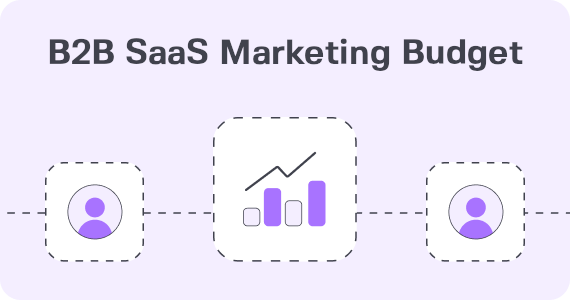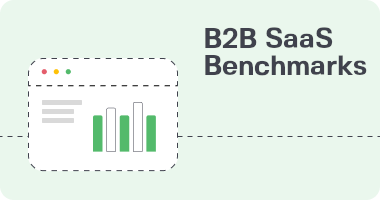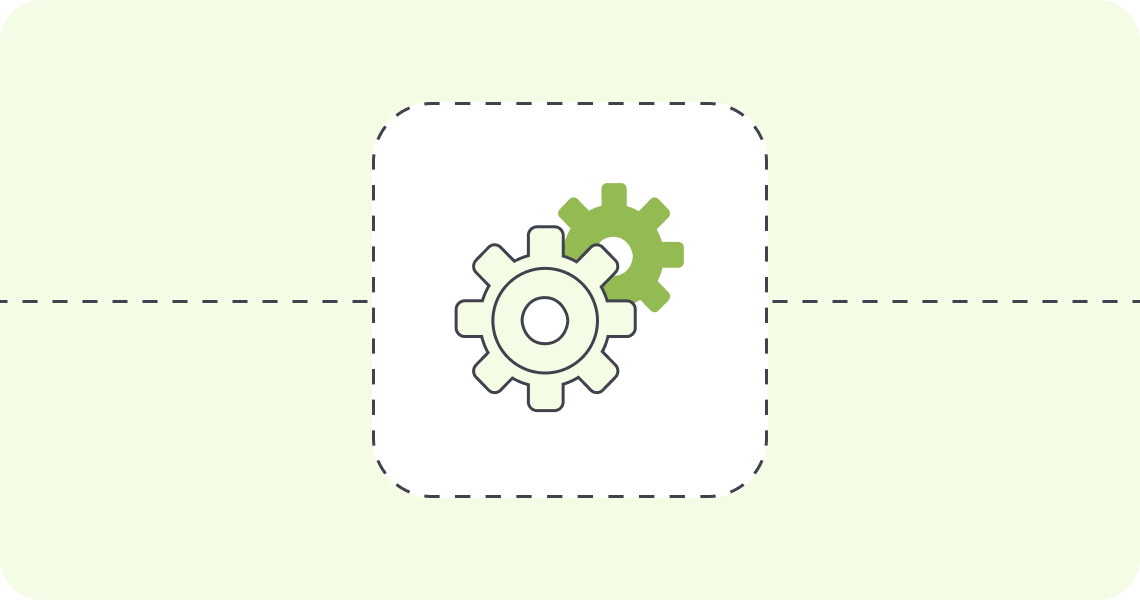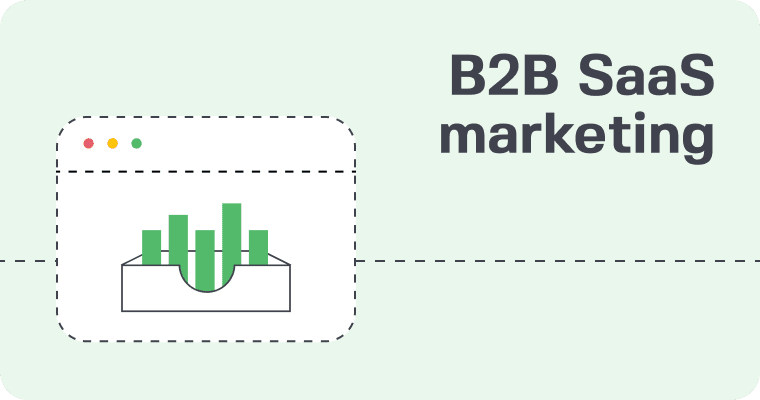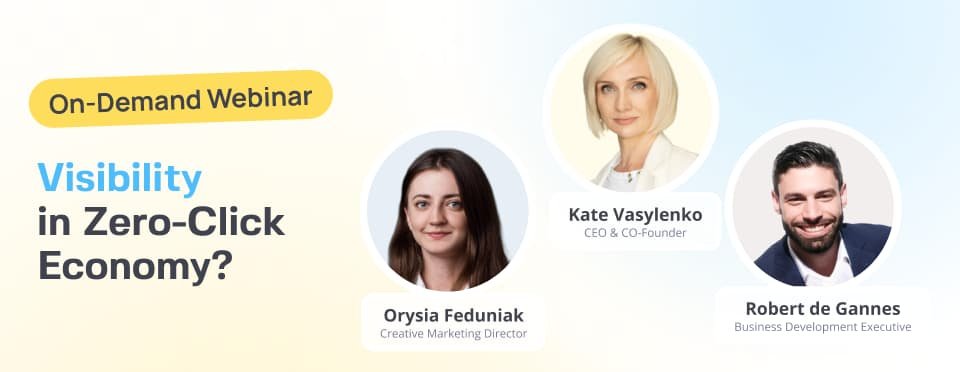B2B SaaS marketing can feel like a complex puzzle, but it doesn’t have to be. Over the years, we’ve seen firsthand what works—and what doesn’t—when it comes to connecting with businesses and driving software adoption.
This guide cuts through the noise, offering direct answers to the 50 most pressing questions you have about building, scaling, and optimizing your B2B SaaS marketing efforts. Ready to ignite your next growth chapter?
🎯 Industry & Strategy
What is B2B SaaS marketing?
B2B SaaS marketing is the set of strategies and tactics that allow you to promote and sell subscription-based software products to other businesses. The main goal is to get customers who you keep long-term in your subscription model. That means maximizing customer lifetime value and minimizing churn. The usual methods to achieve this goal are:
- Lead generation
- Brand awareness
- Conversion optimization
- Customer retention
- Shortening sales cycles
- Lowering CAC (Customer Acquisition Cost)
How to create a B2B SaaS marketing strategy?
Specify your ideal customer profile and unique value proposition. Develop content and SEO strategies. Use targeted lead nurturing. And analyze performance through key metrics like customer acquisition cost and lifetime value.
Why is B2B SaaS marketing different from B2C?
As B2B SaaS marketing targets businesses, the sales cycles are long and include multiple decision-makers. For this reason, it focuses on logic, ROI, and long-term value. In contrast, B2C marketing often relies on emotional appeal to drive quick individual purchases. That said, modern B2B marketing is increasingly combining logic with emotional storytelling. The fact is that even in business, people buy from people they trust. And for that, they need an emotional connection.
What is the B2B SaaS marketing funnel?
The B2B SaaS marketing funnel guides customers from gaining initial knowledge about a brand to becoming loyal users of its software product. It includes four phases:
- Awareness: Users learn about your SaaS as a solution to their problem.
- Consideration: They research and compare it to other options.
- Decision: They choose and buy your SaaS product.
- Retention: You ensure ongoing customer satisfaction and product usage
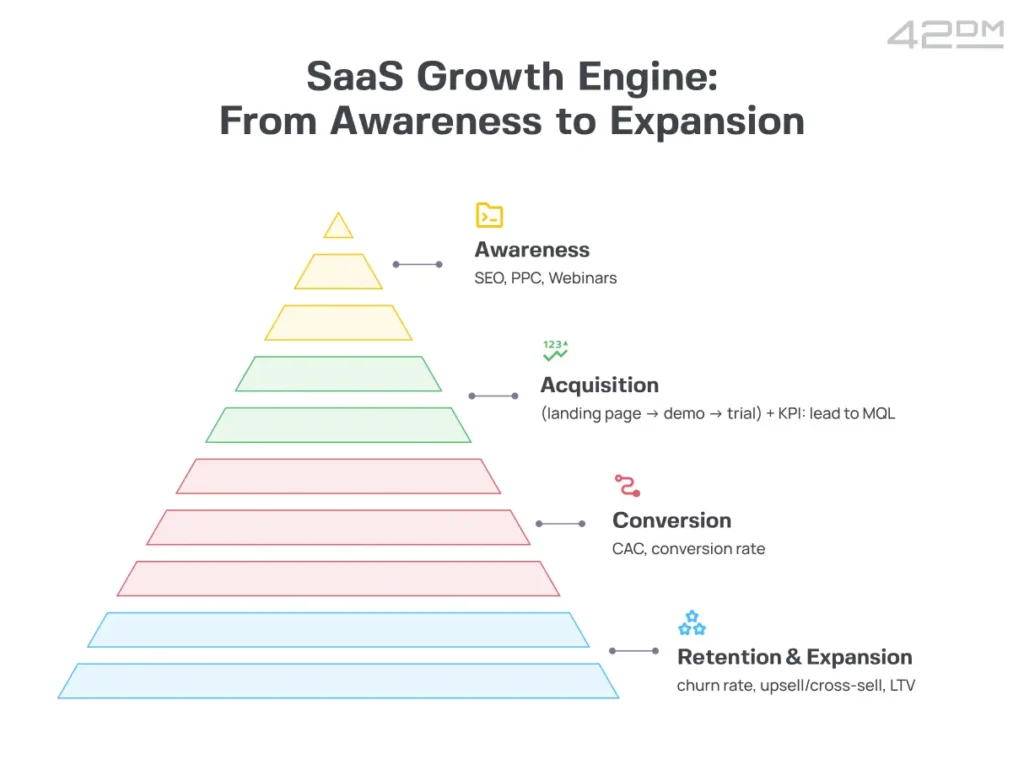
How to define B2B SaaS buyer personas?
B2B SaaS buyer personas are semi-fictional representations of your ideal business customers. Yet, you have to base them on real data and market research to create targeted marketing and sales strategies. When defining your buyer personas, include details like:
- Job role
- Company size
- Pain points
- Goals
- Decision-making processes
What are the top B2B SaaS marketing channels?
The top B2B SaaS marketing channels, all aimed at reaching and engaging business decision-makers, include:
- Content marketing: whitepapers and case studies
- Search engine optimization: SEO content, like blog posts
- Paid advertising: PPC and LinkedIn ads
- Email marketing: newsletters and lead nurturing
- Online events: webinars and workshops
- Account-based marketing (ABM): one-to-one ABM and one-to-many ABM
What is account-based marketing (ABM) in SaaS?
Account-based marketing includes marketing and sales teams collaboratively concentrating efforts on a selected group of high-value, ideal-fit accounts. It helps you engage key decision-makers within those accounts, build deep relationships, speed up sales cycles, and maximize revenue. It’s a highly targeted strategy whose goal is to personalize messaging and outreach across multiple channels.
How to set OKRs for B2B SaaS marketing?
Setting OKRs (objectives and key results) for B2B SaaS marketing is a twofold process:
- Defining ambitious yet achievable objectives (what do I want to achieve?), like more qualified leads, better conversion rates, or boosted brand awareness.
- Specifying measurable key results (how do I measure success?), like conversion rates, annual recurring revenue, and retention rates.
What is B2B SaaS content marketing?
B2B SaaS content marketing means creating and distributing valuable content, like case studies, webinars, and blog posts. The objective is to educate, attract, convert, and retain customers. It allows you to address concrete business pain points and position your company as a trusted authority. It also helps you better guide decision-makers through the long and complex SaaS sales cycle.
How to quantify B2B SaaS marketing ROI?
To quantify B2B SaaS marketing ROI, you must compare the revenue generated from marketing efforts against their cost. The basic formula is the following:
(Revenue Attributable to Marketing – Marketing Spend) / Marketing Spend x 100%
This process requires attributing new customer acquisition, upsells, and reduced churn to specific marketing campaigns. It also factors in the customer lifetime value (CLV) against the customer acquisition cost (CAC) for a complete long-term view.
🔑 SEO & Keyword Research
How to do B2B SaaS keyword research?
Keyword research is nothing else but finding the terms businesses use when searching for software online. Understanding their search intent at different phases of the sales funnel is a core part of the process. Some of the key steps are:
- Analyzing competitor keywords
- Using specialized SEO tools
- Gleaning insights from customer conversations
- Building a keyword list that informs your content strategy
What are high-intent B2B SaaS keywords?
High-intent B2B SaaS keywords are search terms that clearly show that a business is in the later stages of the sales funnel. In other words, it actively looks to buy or subscribe to a software solution. These keywords often include modifiers like “pricing,” “vs,” “review,” “best,” “demo,” or “free trial.” That is precisely what gives away a strong commercial or transactional intent.
How to target long-tail B2B SaaS keywords?
Find highly specific, multi-word phrases that show strong buyer intent and have lower difficulty. Use specialized SEO tools for that purpose. Don’t forget to analyze the long-tail keywords used by your competitors, as well. Then, create detailed content—blog posts, guides, or landing pages—around them to answer niche queries. And use your target audience’s language to build a better rapport.
Should you prioritize volume or difficulty in SaaS SEO?
You should prioritize balance. But generally, pay more attention to difficulty than volume. That’s especially true for newer sites. Targeting lower-difficulty keywords with decent search volume and obvious commercial intent is a great strategy for quicker wins. It can help you build domain authority faster. As your authority grows, you can target difficult, high-volume, and competitive terms.
How to analyze B2B SaaS keyword competition?
Go over the current top 10 positions in Google and other search engines. Evaluate the backlinks pointing to the top 10 results. Assess metrics like keyword difficulty score and domain authority in specialized SEO tools such as MarketMuse. Identify content gaps where competitors haven’t fully addressed a topic. Examine their paid search strategies and, generally, the keywords they rank for, and you’ll be well on your way to success.
What is topical authority for SaaS SEO?
Topical authority in SaaS SEO refers to a website’s authority and credibility on subjects relevant to its software. This strategy doesn’t try to rank for individual keywords. Instead, it strives to showcase deep expertise across all related subtopics within a niche or industry. Topical authority signals to search engines and users that this website is a definitive source of knowledge. It’s a holistic approach often built through content clusters and internal linking.
How to group B2B SaaS keywords?
Organize keywords into thematic clusters based on search intent and sales funnel stage. That means they must share a common underlying purpose—informational, commercial, or transactional. This approach helps structure content around key topics. It enables you to make sure that you create relevant content that addresses actual user needs at the right time.
How to find SaaS keyword search intent?
To find SaaS keyword search intent, you must analyze what a user wants when typing a query. Researching Google’s top search results—looking at content types, ads, and features—helps a lot to understand where a keyword fits in the buyer’s journey. To make things easier on yourself, use an SEO platform that offers intent classifications. You can also gain insights from customer interviews and sales call recordings.
How to leverage PPC data in SaaS SEO?
Use analytic insights from paid campaigns to inform your organic search strategy. Identify high-performing keywords and ad copies that already drive conversions. That will help you understand what messaging resonates best with your target audience. It will also allow you to discover new keyword opportunities and fill content gaps. Then, feed all this understanding into SEO content creation.
How to use CRM data for SaaS keyword insights?
Using CRM data for SaaS keyword insights means extracting information from your CRM to understand the language, problems, and preferences of your target audience. You can analyze sales call transcripts, customer support tickets, and customer journey data. They help you find high-intent, long-tail keywords that resonate with your ideal customers. And remember, if a keyword brings qualified leads and closed deals, use it, regardless of its search volume.
✉️ Content Marketing & SEO Execution
What are the best blog topics for B2B SaaS marketing?
The best blog topics are those that address your target audience’s pain points spot on. They need to educate them on your solutions, build trust, and showcase product value. That includes:
- “How-to” guides
- Client success stories/case studies
- Industry trend analyses
- Product comparison articles
- Thought leadership pieces
- Behind-the-scenes insights into product development or company culture
How to craft SaaS case studies that convert?
Tell a compelling story that’s close to your customers. That means you must:
- Select a client who achieved considerable, quantifiable results
- Clearly outline their initial challenge
- Explain how they implemented your SaaS solution
- Showcase the measurable outcomes and ROI they gained
Use strong and results-driven headlines. Include direct customer quotes and visuals to make the story impactful and believable.
What makes a great SaaS FAQ page?
A great SaaS FAQ page is, above all, user-centric. It offers clear, concise answers to common customer questions about your product, pricing, and support. It’s well-organized with categories or a search function for easy navigation. It also often includes links to deeper resources or contact options for further help. Most importantly, a great SaaS FAQ page is regularly updated and relies on customer support data. Why? To ensure it addresses actual pain points and anticipates user needs.
How to write SEO‑friendly SaaS FAQs?
To write SEO-friendly SaaS FAQs, include relevant keywords while creating concise, helpful answers to common customer questions. That helps you boost your search visibility and address user queries at the same time. Try to target long-tail keywords and featured snippets. Keep in mind that the provided information should clearly support the buyer’s journey. Finally, include proper schema markup to enhance how FAQs appear in search results. This last step can contribute to better click-through rates.
What are the top B2B SaaS content formats?
The best B2B SaaS content formats include:
- In-depth blog articles and guides for awareness and education
- Whitepapers and eBooks for thought leadership
- Case studies and customer success stories for social proof
- Webinars and video demos for deeper engagement and product explanation
- Interactive tools and templates
All of these help you build trust and provide value, aiming to convert and retain customers.
How to create SaaS whitepapers and ebooks?
Begin by setting a clear goal and identifying your target audience. Then, do thorough research and create an outline for your content. Only after that should you write, add design, and promote the content.
Whitepapers are formal and focus on data, aiming to show expertise or address a specific issue. In contrast, ebooks are more educational and engaging, and they act as tools to attract leads. Both need strong visuals, clear calls to action, and effective distribution plans.
How to leverage long‑form content in SaaS SEO?
Long-form content in SaaS SEO means creating comprehensive, in-depth articles (often 1,000+ words). They should cover complex topics relevant to your target audience thoroughly. This approach helps you:
- Rank for numerous keywords
- Establish your brand as an authority
- Attract backlinks
- Guide potential customers through the entire buyer’s journey by offering clear value and answering their burning questions
What is ROI-driven content marketing for SaaS?
Content marketing for SaaS aims to deliver measurable financial returns. To be effective, you should connect each piece of content—like blog posts and case studies—with clear business goals, such as:
- Getting more qualified leads
- Increasing conversion rates
- Reducing churn rates
Be sure to track how this content affects your revenue and customer lifetime value to ensure a positive return on investment.
What are the key steps in executing a B2B SaaS SEO content plan?
Putting a B2B SaaS SEO content plan in practice usually means:
- Carrying out thorough keyword and topic research aligned with buyer intent
- Creating high-quality, in-depth content optimized for target keywords
- Strategically distributing content across relevant channels
- Building high-authority backlinks
- Continuously monitoring performance metrics (rankings, traffic, conversions) for ongoing optimization and refinement
How to leverage use-case–based SEO for SaaS?
Optimize content around specific problems or scenarios that your target audience faces. However, this process must be in line with your offering. So, ask yourself, “Does my software provide a direct solution to this problem?”.
As far as the topics go, create content that fits within the “how-to guides,” “solutions for X,” or “software for Y problem” categories. This way, you’ll directly answer searches related to specific use cases. Moreover, you’ll show your product’s value in real-world applications and attract users with high purchase intent.
📣 Paid Acquisition & Advertising
What is PPC vs. SEO for B2B SaaS?
PPC and SEO are different B2B SaaS marketing strategies. PPC brings immediate, paid visibility through ads at the top of search results. It offers quick traffic and precise targeting, but requires continuous spending. SEO, conversely, focuses on earning organic, unpaid visibility. It achieves this through content quality and website optimization. SEO yields long-term, sustainable traffic and credibility but takes time and consistent effort.
How to run Google Ads for SaaS?
Running Google Ads for SaaS requires a strategic approach focused on high-intent business users. That means you must:
- Define clear conversion objectives (demo requests, free trials, and similar)
- Do extensive keyword research to target commercial intent and pain points
- Craft compelling ad copies that bring value and ROI
- Optimize landing pages for seamless conversions
- Use specific B2B targeting options like audience lists and firmographics
- Track and adjust campaigns based on metrics like CPA, LTV, and conversion rates
How to run LinkedIn Ads for SaaS?
This tactic requires precise targeting of business decision-makers. The best way to achieve this is to use messaging that drives concrete actions. So, to have success:
- Define clear campaign objectives (lead generation, demo requests, etc.)
- Use LinkedIn’s targeting options (job title, industry, company size)
- Create convincing ad creatives and formats (sponsored content, lead gen forms)
- Set up meticulous conversion tracking
- Optimize campaigns continuously in line with performance data
What B2B SaaS advertising metrics matter most?
For B2B SaaS advertising, crucial metrics extend beyond basic clicks and impressions. You should focus on:
- Cost per lead (CPL)
- Marketing qualified leads (MQLs)
- Sales qualified leads (SQLs)
- Customer acquisition cost (CAC)
- Monthly recurring revenue (MRR)
- Customer lifetime value (LTV)
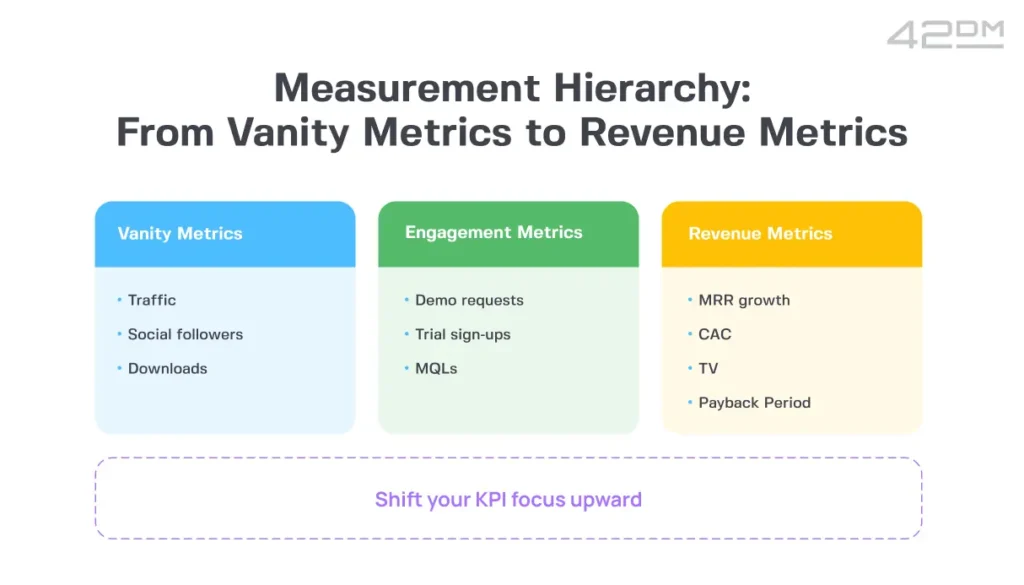
These help you directly measure the profitability and long-term impact of ad spend.
How to set a SaaS ad budget based on ARR?
Setting a SaaS ad budget based on ARR means dedicating a portion of your yearly recurring revenue to advertising. Growth-stage companies usually allocate 10-30%. You can fine-tune this number in two steps:
- Determine your ideal customer acquisition cost
- Calculate how much spending it takes to acquire your desired number of new customers or achieve specific monthly recurring revenue growth
This approach ensures your ad investments support profitable and sustainable revenue growth.
How to optimize SaaS ads for ROI?
You must continuously test and refine various elements of your ads. To do that:
- Segment and refine your audience targeting
- Do A/B testing of ad creatives, headlines, and calls-to-action
- Use strategic bidding models to get high-quality leads
- Track conversions and attribution
- Analyze performance data to reallocate the budget toward the highest-performing campaigns and channels
These tactics will allow every ad dollar to contribute to profitable customer acquisition.
Which high-intent SaaS keywords are best for PPC?
High-intent keywords are those indicating a strong readiness to buy or take action. These include:
- Brand-specific terms: Your brand, product, or competitor brand names
- Transactional terms: “Buy,” “pricing,” “cost,” “free trial,” “demo,” “get started,” “sign up,” or “download”
- Comparison terms: “[Your SaaS] vs. [Competitor],” “best [SaaS category],” “alternatives to [SaaS product]”
- Use case/feature terms: “[Software] for small business,” “[Software] for remote teams,” and similar
What negative keywords should SaaS campaigns use?
Negative keywords help you exclude irrelevant searches, save your budget, and improve ad performance. So, filter out terms falling within these categories:
- To avoid “free” seekers (if you don’t offer a free plan): free, freemium, gratis, etc.
- To avoid competitor searches (if you’re not trying to poach directly): Asana, Trello, Jira, etc.
- To prevent individual/personal use (if you’re strictly B2B): personal, individual, student, etc.
- To prevent job seekers: jobs, careers, hiring, or salary
- To avoid non-software solutions/manual processes: Excel template, spreadsheet, or manual process
- To avoid unrelated industries (if your software is niche): event planning software, hospitality, and more
How to integrate SEO and PPC strategies in SaaS?
To integrate SEO and PPC, you must align keyword targeting, content efforts, and audience insights. That means you use PPC data to:
- Identify high-converting keywords for SEO
- Leverage SEO-driven content for PPC landing pages
- Share keyword research between teams
- Retarget organic visitors with paid ads
The goal is a unified digital presence that captures demand across the entire sales funnel. Along the way, it can also help you optimize ad spending and speed up customer acquisition.
How much does B2B SaaS PPC cost?
B2B SaaS PPC costs can vary. Industry competition, keyword bids, audience specificity, and ad platforms all affect your costs. Nonetheless, it’s worth noting that general benchmarks for cost per click can range from a few dollars to $15-$20+. Still, the total cost depends on the campaign scale, desired cost per lead, or customer acquisition cost. And for B2B SaaS, these can range from hundreds to thousands of dollars per customer.
📊 Metrics & Optimization
Which metrics indicate a healthy B2B SaaS marketing funnel?
A healthy B2B SaaS marketing funnel means:
- Strong marketing qualified lead (MQL) volume
- Efficient lead-to-customer conversion rates
- Low customer acquisition cost (CAC)
- Consistent monthly recurring revenue (MRR) growth
- Low churn rate
- High customer lifetime value (LTV), especially when compared to CAC
How to calculate CAC for SaaS?
Divide your overall sales and marketing expenses over a specific period by the number of new customers acquired in that same period. That factors in salaries, tools, ad spending, and any other expenses related to getting new subscribers. This way, you’ll have a clear figure of how much you spend to gain each new paying customer.
What is CLV, and how to measure it?
Customer lifetime value is a predictive metric. It estimates the total net revenue a customer will generate during their relationship with your company. It’s measured by dividing the average revenue per account by the churn rate. It is often, then, multiplied by the gross margin percentage to reflect profitability. CLV gives insights into the long-term value and sustainability of your customer base.
How to track marketing‑influenced revenue in SaaS?
Use attribution models—first-touch, last-touch, and multi-touch—to assign credit to marketing touchpoints contributing to closed deals. For that, you’ll need CRM integration. A CRM will allow you to connect marketing activities to specific leads and the resulting revenue. The goal of this process is to understand which marketing efforts influence your MRR and ARR.
How to reduce SaaS churn with marketing?
Concentrate on continuous customer engagement and value reinforcement. That means you should:
- Ensure effective onboarding communication
- Offer ongoing educational content that highlights product value and new features
- Share success stories or case studies
- Ask for feedback through surveys
- Use targeted re-engagement campaigns for at-risk users
All these help you nurture long-term satisfaction and adoption.
What retention strategies work for SaaS?
Effective SaaS retention strategies focus on ongoing product value and strong customer relationships. Key elements include:
- Robust customer success management (onboarding, proactive support, health checks, etc.)
- Continuous product improvement (new features, bug fixes, and similar)
- Personalized communication (education, usage tips, and more)
- Community building
- Feedback loops to address pain points and drive feature adoption
The point of these is to maximize user engagement and satisfaction.
How to A/B test SaaS landing pages?
A/B testing refers to creating two or more versions of a page, each with a single changed element, like a CTA or imagery. Then, you split traffic evenly between these versions using an A/B testing tool. It allows you to collect data on key conversion metrics and statistically analyze the results to identify which version performs better. Needless to say, you should then use those insights to optimize your page.
How to improve SaaS conversion rates?
Improving SaaS conversion rates requires optimizing the entire user journey. And to do that, you should:
- Refine website and landing page design for clarity and user experience
- Create persuasive, benefit-driven calls to action
- Personalize content and offers based on user segments
- Simplify sign-up flows and demo requests
- Leverage social proof and testimonials
- A/B test different marketing elements to identify high-performing variations
What role do webinars play in B2B SaaS marketing?
Good webinars play a pivotal role in B2B SaaS marketing. They showcase your product and can serve as powerful lead generation vehicles. They help with thought leadership and educate prospects on viable solutions to their problems. Webinars facilitate direct engagement, build trust, and nurture prospects through the sales funnel.
How to align sales and marketing in SaaS?
Aligning sales and marketing in B2B SaaS requires you to:
- Create a shared understanding of target accounts and buyer personas
- Implement a unified lead scoring system (e.g., MQL to SQL handoff)
- Establish regular inter-departmental communication
- Reach a mutual agreement on revenue goals
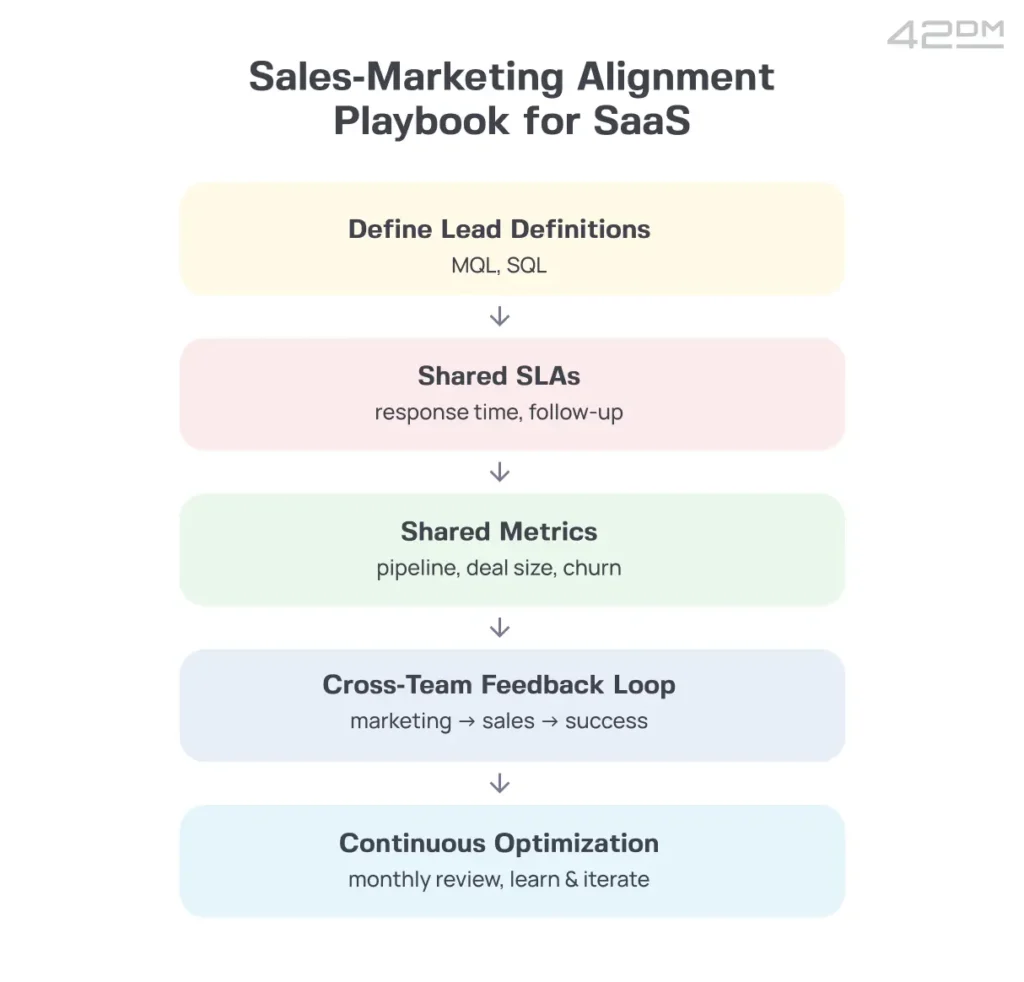
This type of collaboration ensures a seamless customer journey from the initial lead to a closed-won deal. It also fosters mutual accountability for revenue growth.
Final Thoughts
There you have it: Everything you wanted to know about B2B SaaS marketing in 50 simple questions. From defining your core funnel to optimizing ad spend and truly understanding your buyer, we’ve covered the crucial ground of B2B SaaS marketing.
Having navigated these waters for years, we can affirm that B2B SaaS marketing is about relentless optimization, deep customer empathy, and a tight alignment between every piece of your strategy. Master these elements, and your SaaS will not just survive but truly thrive.


